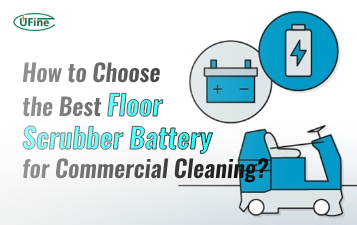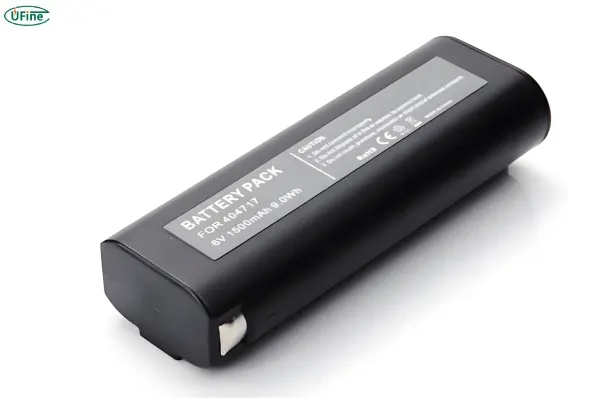6 volt batteries are widely used across many industries and consumer applications, known for their reliability and efficiency. From powering small vehicles to providing backup for solar systems, these batteries serve a range of purposes. But what exactly are 6 volt batteries, and how do they differ from their 12 volt counterparts? This article provides an in-depth look at the different types of 6 volt batteries, their advantages and disadvantages, and much more, including how to charge and maintain them for long-lasting performance.
Part 1. 6 Volt batteries types
The world of 6 volt batteries offers several options, each designed to meet specific needs. The primary types include:
-
Lead-Acid Batteries: These are the most traditional and widely used 6 volt batteries. They are often found in vehicles like golf carts, motorcycles, and vintage cars. Lead-acid batteries use a combination of lead plates and sulfuric acid to generate electrical energy. They come in two subtypes:
- Flooded lead-acid batteries: Require regular maintenance like checking electrolyte levels.
- Sealed lead-acid (SLA) batteries: Maintenance-free and widely used in backup power systems.
-
Lithium-Ion Batteries: These batteries are gaining popularity due to their superior efficiency and lightweight design. Lithium-ion 6 volt batteries are commonly used in modern portable devices and renewable energy systems. Their high energy density allows them to store more power while being smaller and lighter than lead-acid batteries.
-
AGM (Absorbed Glass Mat) Batteries: AGM batteries are sealed lead-acid batteries designed to provide better performance in high-vibration environments, like off-road vehicles or boats. These batteries use a special glass mat to absorb the electrolyte, preventing spillage and reducing the need for maintenance.
-
Gel Batteries: Gel batteries, like AGM, are also sealed and maintenance-free. However, instead of using a glass mat, the electrolyte is suspended in a gel form. This makes them highly resistant to temperature fluctuations and ideal for deep-cycle applications like renewable energy storage or long-term backup power.
Each of these 6 volt battery types has unique features, making it essential to choose the right one based on your specific application.
Part 2. Advantages and disadvantages
Each type of 6 volt battery offers distinct advantages and disadvantages. Let’s break them down in more detail:
-
Lead-Acid Batteries:
- Advantages: Lead-acid batteries are affordable and have been in use for decades, so they’re readily available. They are capable of delivering a high current, making them ideal for starting engines or powering large equipment.
- Disadvantages: These batteries are heavy and require regular maintenance, especially the flooded types. They also have a relatively short lifespan, usually between 2-5 years, depending on how well they are maintained. Their efficiency tends to decrease at low charge levels.
-
Lithium-Ion Batteries:
- Advantages: Lithium-ion 6 volt batteries are lightweight and offer superior energy efficiency. They charge faster and hold a charge much longer than lead-acid batteries. Additionally, they do not suffer from memory effects, meaning they maintain consistent performance throughout their life cycle.
- Disadvantages: The biggest downside is the cost. Lithium-ion batteries are more expensive upfront, though they tend to last longer, making them a better long-term investment. They are also more sensitive to extreme temperatures, which can affect their performance.
-
AGM Batteries:
- Advantages: AGM batteries are known for their low internal resistance, meaning they can deliver high power quickly, which is especially useful in high-performance vehicles or renewable energy systems. They are also highly resistant to vibrations and can function in a range of temperatures.
- Disadvantages: AGM batteries are more expensive than standard lead-acid types and don’t perform well in deep-cycle applications, as repeated deep discharges can shorten their lifespan.
-
Gel Batteries:
- Advantages: Gel batteries are extremely durable and can last a long time, even in extreme temperature conditions. They are also highly resistant to vibration and are great for deep-cycle applications such as solar storage.
- Disadvantages: These batteries are sensitive to overcharging, which can cause damage and reduce their overall lifespan. They are also more expensive than standard lead-acid batteries.
Part 3. What is the difference between 6v and 12v batteries?
One of the key questions when considering a 6 volt battery is how it compares to the more common 12 volt battery. The primary difference is the voltage output. A 6 volt battery provides half the voltage of a 12 volt battery, which means it typically powers devices requiring less energy.
-
Power Output: A 12 volt battery can deliver more power, which is why it’s often used in cars, trucks, and boats. In contrast, 6 volt batteries are used for smaller applications like powering golf carts, old-school toys, or certain backup systems.
-
Series Configuration: Another difference lies in how these batteries can be used in combination. If you need more voltage, you can connect two 6 volt batteries in series to achieve 12 volts. This setup is often seen in older vehicles or specialized equipment.
-
Size and Weight: 6 volt batteries tend to be smaller and lighter than 12 volt batteries, making them easier to handle and install in tight spaces or lightweight applications.
-
Cost: In general, 6 volt batteries are less expensive than 12 volt batteries, though this depends on the battery type (lead-acid, lithium-ion, etc.). However, if you need to connect two 6 volt batteries to achieve 12 volts, the cost may end up being comparable.
Part 4. What is a 6 volt battery used for?
6 volt batteries are extremely versatile and used in various applications. Some of the most common uses include:
-
Flashlights and Lanterns: Many heavy-duty flashlights, especially older models, run on 6 volt batteries, providing long-lasting power in emergency situations.
-
Golf Carts and Small Vehicles: 6 volt lead-acid batteries are commonly used to power golf carts and other small utility vehicles. They offer enough power for the vehicle’s needs while being compact and easy to install.
-
Backup Power for Solar Systems: 6 volt deep-cycle batteries, particularly AGM or gel types, are often used in renewable energy storage systems. These batteries can be connected in series to provide higher voltages, making them ideal for off-grid solar setups.
-
Vintage Cars and Motorcycles: Many classic vehicles use 6 volt electrical systems, requiring 6 volt batteries for starting and running. These batteries are still produced to meet the needs of vintage car enthusiasts.
-
Toys and Medical Equipment: In addition to vehicles, 6 volt batteries are found in children’s toys like electric cars and in medical devices where reliable power is crucial.
Part 5. How long does a 6 volt battery last?
The lifespan of a 6 volt battery depends on the type and how well it is maintained. Lead-acid batteries typically last 2-5 years, though with proper care, they can last longer. Lithium-ion 6 volt batteries tend to last much longer, up to 10 years, and sometimes even longer in ideal conditions.
AGM and gel batteries generally offer better longevity than standard lead-acid batteries, particularly in deep-cycle applications. However, deep discharging or overcharging any battery can drastically shorten its life.
Several factors affect battery lifespan, including:
- Frequency of use
- Depth of discharge (how much of the battery’s capacity is used regularly)
- Environmental factors like temperature and humidity
- Charging practices
Part 6. How do you charge a 6 volt battery?
Charging a 6 volt battery requires using the right charger. Always make sure the charger is designed for your battery type (lead-acid, lithium-ion, AGM, or gel) and set to 6 volts. Follow these steps for safe charging:
-
Connect the charger: Attach the positive cable to the battery’s positive terminal and the negative cable to the negative terminal.
-
Monitor the charging process: Many modern chargers come with automatic shut-off features to prevent overcharging, but it’s always a good idea to monitor the process to ensure everything is running smoothly.
-
Check voltage levels: Use a multimeter to check that the battery is charging properly and not being overcharged. Overcharging can damage lead-acid and gel batteries, reducing their lifespan.
-
Allow time for a full charge: Some batteries, like lead-acid, take longer to charge fully. Make sure the battery is fully charged before disconnecting the charger to maximize its performance
Part 7. Maintenance Tips
Proper maintenance is key to ensuring your 6 volt battery lasts as long as possible. Here are some essential tips:
-
Regularly clean the terminals: Over time, corrosion can build up on the battery terminals, affecting performance. Clean the terminals with a mixture of baking soda and water to remove any corrosion.
-
Check electrolyte levels: For flooded lead-acid batteries, it’s important to check the water level regularly. Add distilled water if needed, but never overfill.
-
Store in a cool, dry place: Extreme temperatures can affect battery performance. Store your battery in a cool, dry place when not in use, especially in cold or hot climates
Related Tags:
More Articles

How to Choose the Best Floor Scrubber Battery for Commercial Cleaning?
Selecting the ideal floor scrubber battery ensures a long runtime, rapid charging, and minimal maintenance for efficient commercial cleaning operations.
Battery for Blower vs Battery for Leaf Vacuum: Which One Should You Choose?
Battery for blower vs leaf vacuum—learn the key differences in power, fit, and runtime to choose the right battery for your outdoor tool needs.
How to Choose the Right Battery for Blower?
Choosing the right blower battery? Consider voltage, capacity, chemistry & usage. This guide helps match the best battery for peak performance.
How to Choose the Best Insulated Battery Box for Lithium Batteries?
Choosing the Best Insulated Battery Box for Lithium Batteries? Discover key factors such as size, material, and safety for optimal protection and performance.
7 Critical Elements on a Lithium Battery Shipping Label
What must be on a lithium battery shipping label? Learn 7 key elements to ensure safety, legal compliance, and correct handling across all transport modes.




